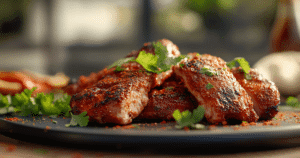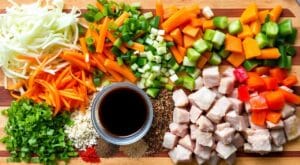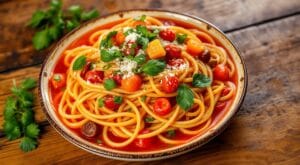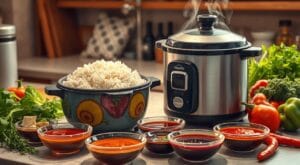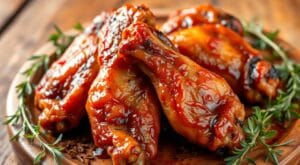Jump to:
Estimated reading time: 10 minutes
Table of contents
When baking yams, boiling them first is a common step. This method can make cooking faster. By boiling the yams, you cut down the baking time. This makes cooking quicker and more efficient.
Knowing how boiling changes the taste and texture of yams is important. It helps you get perfectly cooked yams every time.
Key Takeaways
- Boiling yams before baking can speed up the overall cooking time by partially cooking the yams.
- Boiling affects the texture and flavor of yams, so understanding the best practices is crucial.
- The boiling method can help reduce baking time and result in more efficient cooking.
- Properly boiling yams can enhance their natural sweetness and caramelization during baking.
- Boiling yams can also increase the bioavailability of certain nutrients like beta-carotene.
Introduction
Yams are a versatile root vegetable that can be prepared in many ways, including baking. Many wonder if they should boil yams before baking them. This article will look at the pros and cons of boiling yams before baking. It will also guide you through the boiling process and explore other cooking methods to get perfect yams every time.
Preparing yams is key to getting the right texture and flavor. Precooking yams through boiling can affect the final taste when baking. Knowing the different yam cooking methods and their effects can help you choose the best method for your recipe.
Whether you’re a seasoned chef or a home cook, this article will give you valuable insights. It will help ensure your baked yams are delicious every time.
Why People Ask: Should You Boil Yams Before Baking?
Many cooks wonder if they should boil yams before baking. They want the perfect texture and flavor in their dish. Boiling yams can make them softer, which can lead to a creamier, more tender texture when baked.
| Boiling Yams Before Baking | Baking Yams Without Boiling |
|---|---|
| Helps soften the yams, leading to a creamier texture. | May result in a firmer, more dense texture. |
| Can reduce baking time. | Requires longer baking time to fully cook the yams. |
| Allows for better seasoning and flavor absorption. | Flavors may be less pronounced or evenly distributed. |
Whether to boil yams before baking depends on your preference and what you want to achieve. Knowing the pros and cons of each method can help you choose the best option for your dish.
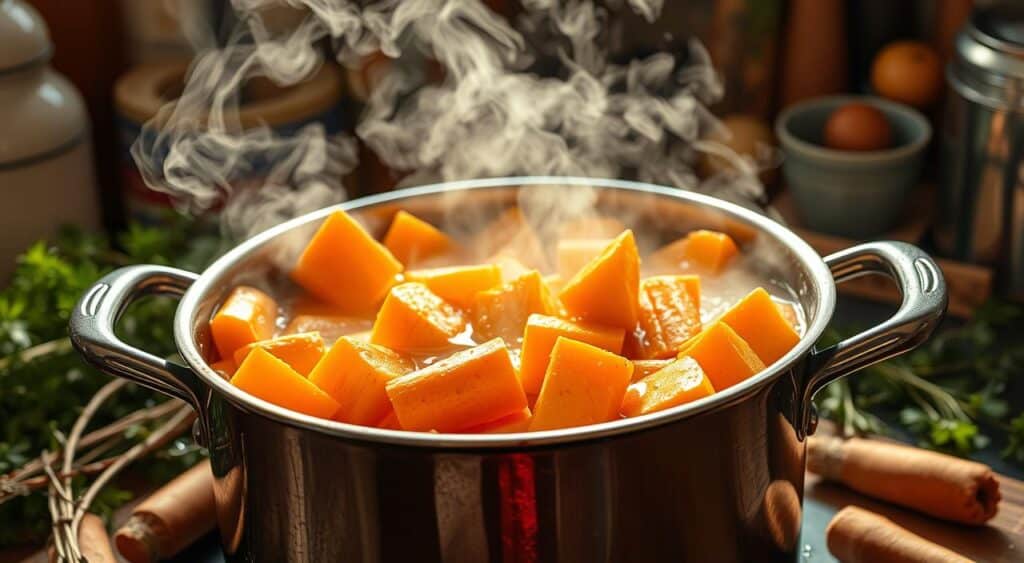
“Boiling yams before baking is a game-changer. It ensures the perfect texture and helps the flavors really shine through.”
Why People Ask: Should You Boil Yams Before Baking?
Many wonder if they should boil yams before baking them. The answer depends on the yam’s texture and taste, and how you cook them.
Understanding the Texture and Taste of Yams
Yams are sweet and slightly nutty. Their texture varies, from creamy to firm. Boiling makes them soft for mashing, while baking caramelizes their sugars.
Common Methods for Cooking Yams
Yams can be boiled, baked, roasted, or steamed. Each method changes their texture and taste. Boiling is quick, while baking or roasting sweetens them.
When Boiling Yams Makes a Difference
Boiling yams before baking is key for dishes like candied yams. It softens them for quicker baking. This is great for big batches at holidays.

“Boiling sweet potatoes with the skin on provides a boost of fiber and potassium.”
Boil Yams Before Baking: Pros and Cons
Should you boil yams before baking them? The answer is not simple. There are both good and bad sides to this method. Let’s look at the benefits and drawbacks of boiling yams before baking.
Benefits of Boiling Yams Before Baking
Boiling yams before baking can save time. It partially cooks them, making the baking process quicker. This is great when you’re short on time or need to cook a lot of yams.
Boiling also makes yams softer. This is good for recipes where you want a creamy texture. It helps keep the yams moist and sweet.
Downsides of Boiling Yams
Boiling yams has its downsides too. One big issue is losing nutrients. Boiling can reduce water-soluble vitamins like vitamin C. It can also make the yams less flavorful than roasting or baking at high temperatures.
Boiling can also make yams too soft or mushy. While it makes them tender, it doesn’t always keep their texture right. For firmer yams, try roasting or microwaving instead.
When to Skip the Boiling Step
For better flavor and texture, skip boiling. Baking or roasting yams without boiling can make them sweeter and more intense. This method also keeps them firmer, which is good for some dishes.
Steaming is another option. It keeps more nutrients and softens the yams, balancing the good and bad of boiling.
Whether to boil yams before baking depends on your taste and recipe. Knowing the pros and cons helps you choose the best way to cook yams every time.
How to Boil Yams Before Baking
Boiling yams before baking makes them tender and perfect. It’s a simple step that makes a big difference. Here’s how to boil yams before baking.
Step-by-Step Guide to Boiling Yams
- First, wash the yams well under running water. Use a brush to get rid of dirt.
- Peel the yams or leave the skin on, as you like. Cut them into 1-inch cubes for faster cooking.
- Put the yam cubes in a big pot and cover them with water. Add a pinch of salt.
- Boil the water, then lower the heat to medium. Let the yams simmer for 15 to 20 minutes, until they’re soft.
- Drain the yams in a colander and let them cool a bit before baking.
How Long to Boil Yams for Best Results
Boil yams for 15 to 20 minutes for the best texture. Boiling too long makes them mushy. Boiling too short makes them tough. Check with a fork or knife to see if they’re done.
Tips for Maintaining Flavor and Nutrients
- Use a pinch of salt in the boiling water to bring out the yams’ sweetness.
- Don’t boil the yams in too much water to keep nutrients in.
- Drain the yams well after boiling to avoid them getting soggy.
- Adding a bit of butter or olive oil to the water can add flavor.
- Refrigerate boiled yams in an airtight container for up to 4 days.
By following these steps and tips, you’ll be able to boil yams before baking to achieve the perfect texture and flavor every time.
Alternative Cooking Methods for Yams
Boiling yams is common, but there are other ways to cook them. You can roast yams without boiling or steam or slow cook them. Each method brings out different flavors and textures.
Roasting Yams Without Boiling
Roasting yams makes them sweeter and gives them a caramelized outside. Peel and cube the yams, then toss with olive oil, salt, and seasonings. Spread them on a baking sheet and roast at 400°F for 30-40 minutes until tender and golden.
Steaming Yams as an Alternative to Boiling
Steaming yams is a great way to cook them. Place peeled and cut yams in a steamer basket over boiling water. Cover and steam for 15-20 minutes until tender. Steaming keeps the yams’ nutrients and flavors, making them fluffy and delicate.
Slow Cooking Yams for Maximum Flavor
Slow cooking yams is a hands-off method. Put peeled and cubed yams in a slow cooker with some liquid. Let them cook for hours. This method makes the yams rich in flavor and soft in texture.
Choosing to roast, steam, or slow cook your yams opens up new ways to enjoy them. These methods show how versatile and tasty yams can be.
| Cooking Method | Texture | Flavor | Nutrient Retention |
|---|---|---|---|
| Roasting | Caramelized exterior, soft interior | Concentrated, sweet, and savory | Moderate |
| Steaming | Fluffy and tender | Delicate and natural | High |
| Slow Cooking | Creamy and soft | Rich and concentrated | Moderate |
Common Mistakes When Boiling Yams Before Baking
Preparing yams right is crucial for their texture and taste. Avoiding over-boiling yams and boiling them in too much water is important. Also, not seasoning the water properly can make the dish less flavorful. Let’s look at these mistakes and how to fix them for delicious yams.
Over-boiling Yams: How It Affects Texture
Boiling yams for too long is a common error. A short boil is better to avoid mushiness. The United States Sweet Potato Council suggests boiling whole sweet potatoes for 35 to 40 minutes. This ensures they stay creamy and firm.
Boiling Yams in Too Much Water
Boiling yams in too much water is another mistake. It makes them absorb too much water, leading to a watery texture. The Food and Drug Administration recommends using just enough water to cover the yams. This helps them cook evenly without becoming too wet.
Not Seasoning the Water Properly
Not seasoning the water can also affect the yams’ flavor. Adding a pinch of salt or herbs can enhance their natural sweetness. Seasoning the water infuses the yams with more flavor, making the dish better.
By avoiding these mistakes and following the right steps, your yams will come out perfectly. They’ll be ready to be baked to perfection.
Frequently Asked Questions: Should I boil my yams before baking?
What are the benefits of boiling yams before baking?
Boiling yams before baking softens them, making it easier to achieve a tender texture in less time. It can also help with even cooking, especially if you want a soft, caramelized texture for candied yams.
Will boiling affect the flavor of baked yams?
Boiling can slightly dilute the natural sweetness of yams or sweet potatoes, as some of the sugars and nutrients may be lost in the water. If you prefer a richer, more concentrated flavor, you may want to skip boiling and bake the yams directly.
Is it necessary to boil yams for faster candied yams?
Boiling isn’t necessary but can save time. If you don’t boil, slice the yams thinly and cover them with foil while baking to ensure they cook through evenly.
Can I skip boiling and just bake the yams directly?
Yes, you can bake yams directly without boiling. Simply slice them evenly, coat with your butter and sugar mixture, and bake at a moderate temperature (around 350°F) until tender, which usually takes 45-60 minutes.
Conclusion: Achieving the Perfect Yams Every Time
Boiling yams before baking can make cooking faster and the dish more tender and flavorful. By learning how boiling affects the texture and taste of yams, you can make perfect baked yams every time.
Try boiling, roasting, steaming, or slow cooking your yams to find what works best for you. Baking yams without boiling can bring out their natural sweetness. Boiling can soften them and cut down baking time.
Mastering different yam cooking methods lets you make tasty and healthy dishes. From mashed yams to roasted yam wedges, the options are endless. With confidence in handling these versatile root vegetables, you’ll impress everyone with your creations.

